Content Warning
The following page may contain non-graphic discussions of fictional CSA, incest, child death, and homophobic stereotyping.
Dune Adaptations
Note: I will only be looking at adaptations of the first Dune novel.
Dune is a book that lends itself to adaptation. The story itself is relatively simple and follows traditional narrative structures. The worldbuilding is complex, but it's open to visual interpretation. The same can be said for the characters.
Dune is also a book that is impossible to adapt. A lot of the book's meaning is constructed through internal monologues. Drug-induced hallucinations make up large batches of the wordcount. The story features large sandworms and spaceships and intense battles, which are going to chew through any adaptation's budget.
Both of these ideas can co-exist at once, and that's why I love Dune adaptations. Making an adaptation is a huge, complex undertaking. Few have succeeded at making something good, but everybody who tries ends up with something interesting.
This page will serve as a home for my thoughts and feelings about the Dune adaptations.
Points of Interest
As well as providing a summary of my feelings towards these adaptations, I'll be highlighting the following elements because they're the parts of a Dune adaptation that I find the most interesting:
- Plot Changes
Obviously, every adaptation is going to change the plot at least a little.
I'm interested in figuring out what's been changed, why it's been changed, and if the changes make sense for that particular adaptation.
- The Feyd-Rautha Cunt-O-Metre
Feyd-Rautha Harkonnen is a secondary antagonist in the book. He is the Baron's youngest nephew, the heir to House Harkonnen (a Na-Baron), and my absolute favourite character.
As a villain and a character foil for Paul, there's so much you can do to make Feyd a compelling, entertaining villain. Not to mention the fact that the Harkonnens are queer-coded in the book.
As such, I'll be keeping a close eye to see how much cunt they let Feyd-Rautha serve. The more the better.
(This isn't actually a metre of any kind. I'm not gonna be assigning a numerical value or anything. It's just for fun.)
Adaptations
Frank Herbert's Dune (2000 Miniseries)
Note: I didn't rewatch the entire miniseries before writing this section, so some details may be inaccurate.
Frank Herbert's Dune is a Syfy miniseries released over three parts and clocking in at 295 minutes in total (if you nab the Director's Cut, which I think is the version I watched).
This miniseries is clearly the lowest budget of all filmed Dune adaptations. I haven't actually compared the budgets but you can just kind of tell by looking at it. It has a big "amateur theatre" vibe, especially with the costuming and the sets. The outfits are occasionally ambitious, but they're clearly made from cheap materials. My favourite example of this is Countess Margot Fenring, who has a doily superglued to her bald head in a vein effort to look alien and futuristic. Shout-outs also go to Feyd-Rautha's floating triangle back bling and Irulan's hot glue butterfly dress. Shantay you stay.
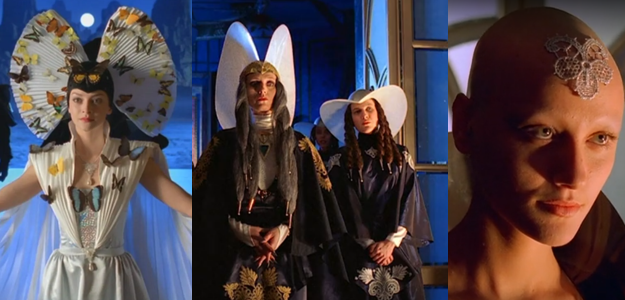
This is what fashion will be in 2013
This might sound like I think Frank Herbert's Dune sucks, but I really don't. The cheap vibe is actually one of things working in it's favour. Much like the Lynch adaptation, there's a sense of ambition that isn't fully realised. But the low budget forces some clever solutions. For example, there's a number of hand-painted backgrounds that don't quite give a realistic sense of depth, but are still nice to see. The greatest cheap special effect is the one used for the kangaroo mouse, where the creature has been realised as a stop-motion puppet. Its proportions are not "realistic" in any way - it fully looks like a muppet - but it's nonetheless charming and really makes me smile.
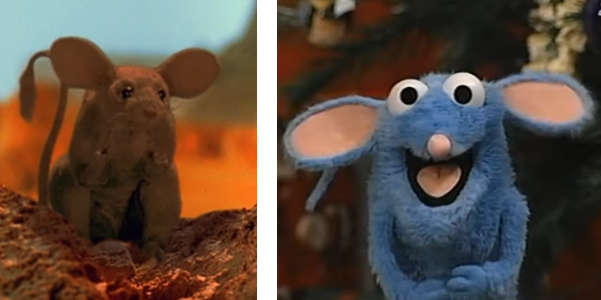
Swapped at birth?
There are points where grand battles take place in the deep desert, but it's literally like 10 or so people on a set so small they can't use any camera angles other than dead-on facing the background. And then we have the CGI, which literally looks like a video game cutscene.
That said, there are parts of the adaptation that I'm much less a fan of. Specifically, Paul. Paul sucks ass in this version. From the minute they land on Arrakis, he's constantly bitching and moaning and trying to come across as the most intelligent person in the room. He's not a compelling protagonist at all. This isn't entirely the actor's fault. Alec Newman gives a perfectly adequate performance. However, I do feel that he was somewhat miscast. For one, he doesn't look remotely close to the correct age for Paul. And he has much more of a generic dream-boat actor appearance, which feels somewhat anachronistic among all the medieval inspired aesthetics. Without a compelling Paul, it's hard to actually give a shit about anything happening in the plot.
On the other hand, the Baron is the most entertaining character in this miniseries. He's portrayed by English actor Ian McNeice of Doc Marten and Doctor Who fame. He smashes this role out of the park. I spent every scene that didn't include the Baron waiting and praying for the Baron to show up. He is theatrical and exaggerated, but there is also a real menacing undercurrent to his performance. He is canonically gay in this miniseries, and does murder one of his sex slaves, but that plot line is a little less grim than the book (the sex slave is seemingly an adult in the miniseries...). And the scene ends with the Baron wearing the greatest outfit of any Baron ever.
There's also a moment in the first episode where the Baron is shown with a paper fan made of knives. It's later revealed that the entire Harkonnen army uses these fans as weapons. It's so camp, I love it.

Peak
The plot itself feels a little muddled. It is, most of the time, incredibly accurate to the book. Unfortunately, the book is really complicated and very dependant on the character's internal monologues, which means the details get lost in adaptation. It also results in a series that is very dry (like Arrakis, I guess).
Interestingly, the show found a solution for this issue, but only does it once. After Duke Leto and Piter's death in episode one, the Baron looks dead into the camera and delivers a soliloquy to the audience. Straight up, he just breaks the fourth wall. And it slaps! It certainly plays back into that "cheap theatre" vibe, but in a way that feels purposeful and charming. I wish the series did it more because it feels like such a natural choice for Dune, and almost feels Shakespearean. I think somebody should make an adaptation of Dune that's written like The Big Short.
Another stylistic choice I like is the show's use of lighting. Maybe it's just because I'm writing this from a time when everything is too fucking dark and all the lighting must be 100% realistic, but I really appreciate the way this series blasts its actors with bright-ass neon lights during darker scenes. For some reason, Arrakis in this adaptation has a moon that emits a green spotlight glow, so every night-time scene is backlit with green neon. It's not realistic obviously (how would anybody sleep?), but it looks rad. Giedi Prime gets a similar treatment, but with bright red lighting, so you know that the planet is eeeevillll.
Similarly, the eyes of Ibad in this series are not just deep blue, but actually glow in the dark. I'm not entirely sure how this effect is done (I'm assuming it's just added in post onto some blue contact lenses, but it seems kinda too consistent for that), but it looks really freaky and cool. It's by far my favourite interpretation of the eyes of Ibad.
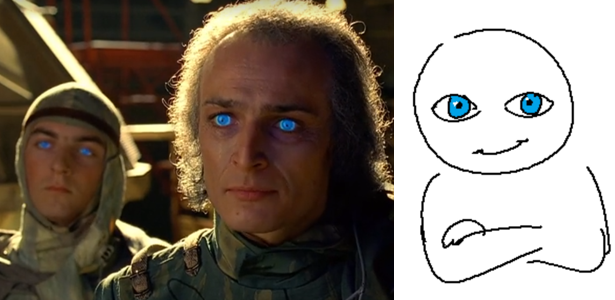
People with blue-eyes be like
Lastly, I just want to draw attention to two thing I really enjoy, and one thing I do not.
There's a point where Feyd-Rautha is practicing for the arena with the lads (basically he's just beating up a slave for fun), and the footage of the fight is intercut with a monologue by the Baron about taking down House Atreides. It's just a good introduction to the Harkonnens and has some real drama and style to it.
The other thing I love is the representative of the guild who goes so damn hard in his performance. He's constantly JoJo posing and delivers all of his lines in such an absurd way.
Give this man an Oscar
The thing I do not like is that the introduction to Chani is basically just a shot of her bare boobs that goes on for way too long. Ew.
Plot Changes
As I've said, this adaptation is incredibly close to the book in plot. Being a miniseries gives them way more time to actually tell the story, so they can hit almost all of the beats. Unlike most other adaptations, most of the plot changes are additions, not subtractions.
The first and simplest change is that there are no scenes that take place on Caladan. Instead, the series begins immediately with House Atreides on the ship to Arrakis. This is presumably to save on sets and time and doesn't really impact the plot too much.
However, I'm most interested by the new scenes that are added with Irulan. Irulan gets a lot of wordcount in the book as the author of the extracts that are interspersed throughout the story. However, she's not actually physically present for much of the story, and she has basically no agency in the plot.
In the miniseries, Irulan gets a small sublot where she goes to Giedi Prime during Feyd-Rautha's birthday celebration to investigate her father's possible involvement in the death of Leto Atreides.
Irualan visiting Harko
This subplot is initiated by Irulan saying she must become "less naive", and seek out answers herself. Her methods of subterfuge are... questionable. She finds Feyd-Rautha engaged in a PG-13 orgy and decides to get information out of him by flirting. I'm all for Irulan being a stealthy girlboss, but heading into Harkonnen territory feels incredibly dangerous and naive. Openly flirting with the heir of a noble house feels like something the Emperor's daughter should not be doing so casually (Feyd kisses her neck in this scene??). Thankfully, she gets out of Giedi Prime scott-free because Feyd has no object permanence and gets distracted by Margot Fenring.
Irulan also gets an extra scene with Paul in episode one. She is a guest in attendance of a dinner party hosted by Lady Jessica and she has a little flirt with Paul. Unlike the scene with Feyd, this flirting feels much more appropriate and honestly kind of cute. Also, Paul isn't naked, which helps.
I find these additions to be a good idea in theory, but very messy in execution. These scenes sort of serve to establish a bit of a love triangle. Not only does it lay the groundwork for the love triangle between Paul, Irulan and Chani, but it also implies a love triangle between Paul, Irulan and Feyd. The former sets up the central conflict at the end of the story, which carries on into Children of Dune (2003), and the latter sets up some extra emotional weight to the duel between Paul and Feyd for Irulan's hand in marriage. Furthermore, giving the audience more insight into Irulan as a character makes her more sympathetic and engaging.
But in practice, it also makes Irulan seem a little flippant and, ironically, naive. The miniseries in general doesn't handle emotions well, and it absolutely fails at romance at every turn. So trying to add a will-they/won't-they with Paul at the start of the series falls a little flat. And the scene with Feyd is just kind of wierd. It feels like an excuse to include more nudity for ratings purposes (or make the show feel more mature, perhaps). There's very little consequences the scene has on the characters or plot, even though Irulan just exercised her first bit of agency ever and Feyd just divulged serious family secrets. Near the end of the miniseries, Feyd tries to flirt with Irulan and Irulan playfully shuts him down. During this scene, neither of these characters behave as though they literally almost had sex a few years go! It's like it never happened. It's so odd.
Feyd-Rautha Cunt-O-Meter
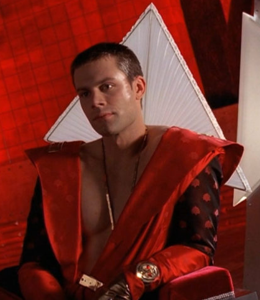
Matt Keeslar as Feyd-Rautha
I had such low hopes for this Feyd-Rautha to ever serve cunt. His casting has the same problem as Paul - He has such American high-school soccer player energy. Or like... Lacrosse player. I don't know what lacrosse is, but this dude for sure plays it.
That first impression was mostly accurate, but there is a little cunt served by this Feyd. Firstly, his main outfit is awful, as are most outfits in this miniseries, but the more I saw it, the more I appreciated the vibe. Feyd seems to spend his whole time lounging around the palace in a fancy dressing gown, half-open. I love that for him. There's also a classic homoeroticism to the outfit that I appreciate. The triangle back bling has to go, though.
The homoeroticism continues in his duel with Paul, which is done in their underwear. The fight ends with Feyd fully straddling Paul, pinning him the ground. It's very... Greek wrestling.
And, of course, this Feyd does show his entire bare ass on screen. I have to respect that.
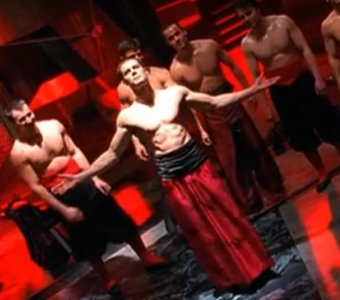
Tits out for the lads
Nevermind serving cunt, by the way, this Feyd straight up is a cunt, in very delightful, villainous ways. My favourite moment is when he spits on the floor of the palace in Arrakis. So unnecessary. It's such attention seeking behaviour, which is something I love to see in an adaptation of Feyd.
The actor does imbue some sass into some of his line reads and mannerisms as well. There's a scene of Rabban getting berated by the Baron, which then features Feyd looking smug and sauntering away.
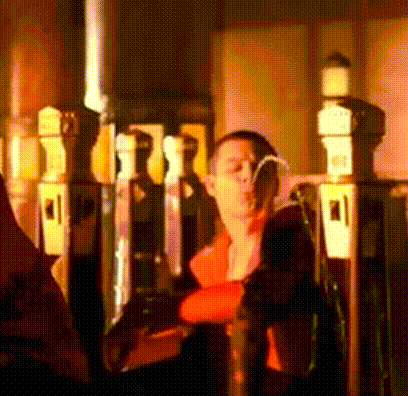
Thanks to harkonnenanimal for putting this gif on Tenor, and describing it as "naughty"
Overall, this Feyd is pretty mid, but he does have some stand-out iconic moments. I guess I just wish he had more interesting hair...

